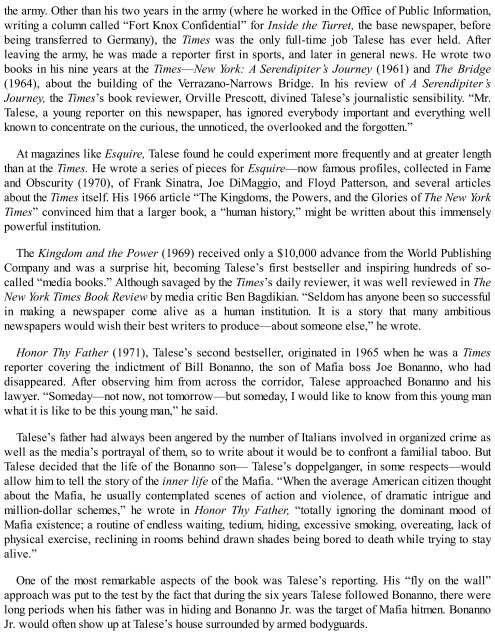72395873289
You also want an ePaper? Increase the reach of your titles
YUMPU automatically turns print PDFs into web optimized ePapers that Google loves.
the army. Other than his two years in the army (where he worked in the Office of Public Information,<br />
writing a column called “Fort Knox Confidential” for Inside the Turret, the base newspaper, before<br />
being transferred to Germany), the Times was the only full-time job Talese has ever held. After<br />
leaving the army, he was made a reporter first in sports, and later in general news. He wrote two<br />
books in his nine years at the Times—New York: A Serendipiter’s Journey (1961) and The Bridge<br />
(1964), about the building of the Verrazano-Narrows Bridge. In his review of A Serendipiter’s<br />
Journey, the Times’s book reviewer, Orville Prescott, divined Talese’s journalistic sensibility. “Mr.<br />
Talese, a young reporter on this newspaper, has ignored everybody important and everything well<br />
known to concentrate on the curious, the unnoticed, the overlooked and the forgotten.”<br />
At magazines like Esquire, Talese found he could experiment more frequently and at greater length<br />
than at the Times. He wrote a series of pieces for Esquire—now famous profiles, collected in Fame<br />
and Obscurity (1970), of Frank Sinatra, Joe DiMaggio, and Floyd Patterson, and several articles<br />
about the Times itself. His 1966 article “The Kingdoms, the Powers, and the Glories of The New York<br />
Times” convinced him that a larger book, a “human history,” might be written about this immensely<br />
powerful institution.<br />
The Kingdom and the Power (1969) received only a $10,000 advance from the World Publishing<br />
Company and was a surprise hit, becoming Talese’s first bestseller and inspiring hundreds of socalled<br />
“media books.” Although savaged by the Times’s daily reviewer, it was well reviewed in The<br />
New York Times Book Review by media critic Ben Bagdikian. “Seldom has anyone been so successful<br />
in making a newspaper come alive as a human institution. It is a story that many ambitious<br />
newspapers would wish their best writers to produce—about someone else,” he wrote.<br />
Honor Thy Father (1971), Talese’s second bestseller, originated in 1965 when he was a Times<br />
reporter covering the indictment of Bill Bonanno, the son of Mafia boss Joe Bonanno, who had<br />
disappeared. After observing him from across the corridor, Talese approached Bonanno and his<br />
lawyer. “Someday—not now, not tomorrow—but someday, I would like to know from this young man<br />
what it is like to be this young man,” he said.<br />
Talese’s father had always been angered by the number of Italians involved in organized crime as<br />
well as the media’s portrayal of them, so to write about it would be to confront a familial taboo. But<br />
Talese decided that the life of the Bonanno son— Talese’s doppelganger, in some respects—would<br />
allow him to tell the story of the inner life of the Mafia. “When the average American citizen thought<br />
about the Mafia, he usually contemplated scenes of action and violence, of dramatic intrigue and<br />
million-dollar schemes,” he wrote in Honor Thy Father, “totally ignoring the dominant mood of<br />
Mafia existence; a routine of endless waiting, tedium, hiding, excessive smoking, overeating, lack of<br />
physical exercise, reclining in rooms behind drawn shades being bored to death while trying to stay<br />
alive.”<br />
One of the most remarkable aspects of the book was Talese’s reporting. His “fly on the wall”<br />
approach was put to the test by the fact that during the six years Talese followed Bonanno, there were<br />
long periods when his father was in hiding and Bonanno Jr. was the target of Mafia hitmen. Bonanno<br />
Jr. would often show up at Talese’s house surrounded by armed bodyguards.









![Genki - An Integrated Course in Elementary Japanese II [Second Edition] (2011), WITH PDF BOOKMARKS!](https://img.yumpu.com/58322134/1/180x260/genki-an-integrated-course-in-elementary-japanese-ii-second-edition-2011-with-pdf-bookmarks.jpg?quality=85)
![Genki - An Integrated Course in Elementary Japanese I [Second Edition] (2011), WITH PDF BOOKMARKS!](https://img.yumpu.com/58322120/1/182x260/genki-an-integrated-course-in-elementary-japanese-i-second-edition-2011-with-pdf-bookmarks.jpg?quality=85)





